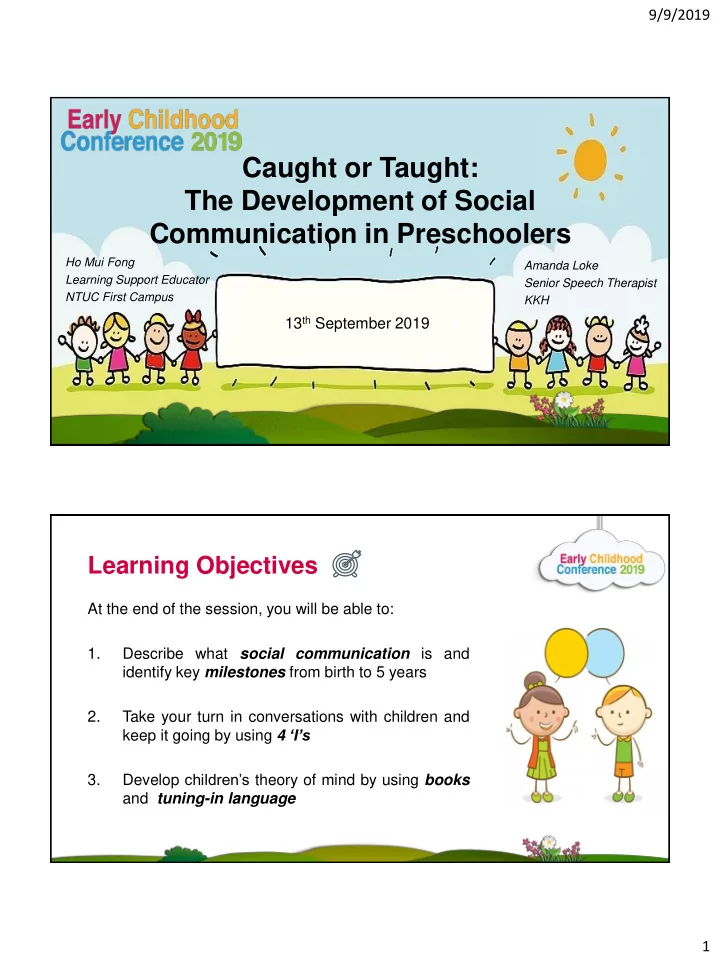

9/9/2019 Caught or Taught: The Development of Social Communication in Preschoolers Ho Mui Fong Amanda Loke Learning Support Educator Senior Speech Therapist NTUC First Campus KKH 13 th September 2019 Learning Objectives At the end of the session, you will be able to: 1. Describe what social communication is and identify key milestones from birth to 5 years 2. Take your turn in conversations with children and keep it going by using 4 ‘I’s Develop children’s theory of mind by using books 3. and tuning-in language 1
9/9/2019 What is Social Communication? Communication: Sending and receiving messages Social communication: Language that is used to interact with others in a variety of social situations . It involves the use of – Nonverbal behaviours (e.g. eye gaze, facial expressions, gestures) Language (to be able to understand and talk to others) Social interaction (to know what to say or how to behave with others) Social cognition (to understand the thoughts of others) What is Social Communication? 2
9/9/2019 Birth to 12 Months Prefers looking at people and listening to human voices Reacts to different tones of voice (e.g. angry, friendly) Smiles back at caregiver Participates in vocal turn-taking with caregiver Vocalises to get attention Points to share an experience (joint attention) Uses gestures to make requests and direct attention Plays simple interactive games, such as peek-a- boo 12 to 18 Months Brings objects to show caregivers Requests by pointing and vocalising Gains attention vocally Says “bye” and other routine words Protests by shaking head or saying “no” Uses gestures with verbal language to communicate Responds to the speech of others with eye contact 3
9/9/2019 18 to 24 Months Uses single and short phrases to command, indicate possession, express problems, and gain attention Uses pronouns: I, me, you, my, and mine Participates in verbal turn-taking with limited number of turns Interrupts at appropriate times 2 to 3 Years Engages in short dialogues Verbally introduces and changes topic Expresses emotion Clarifies and asks for clarification 4
9/9/2019 3 to 4 Years Engages in longer dialogues Displays improving conversational skills: o Anticipates next turn in conversation o Ends conversation appropriately Uses fillers – such as yeah and okay – to acknowledge a o partner’s message o Makes conversational repairs when not understood and corrects others Appropriately role-plays Begins code-switching and uses simpler language when talking to very young children Starts telling simple stories – will describe a few events 4 to 5 Years Uses twice as many effective utterances as 3-year-olds to discuss emotions Tells stories with unfocused chains – stories have sequence of events, but no central character or theme Develops basic understanding of Theory of Mind (ToM) o ToM: The ability to attribute mental states – beliefs, intents, desires, pretending – to oneself and others and to understand that others have beliefs, desires, and intentions that are different from one's own. 5
9/9/2019 The 4 ‘I’s… Include child’s interests, ideas and words Interpret child’s message Introduce new ideas Insist on a change of topic (if child is fixated on a particular topic) …help you to take your turn! Include child’s interests, ideas and words Someone swimming. But do you know that fishing is the biggest participant sport in the What are you world? drawing? Fishing! I thought Football is a sport football would be that is most watched more popular. in the world. 6
9/9/2019 Interpret child’s message John took the toy away from you and you could not play with it. That’s making you cry and you feel sad now. The toy no more! [cries] Introduce new ideas Are you going to No, I’m going to read ‘The Hungry read ‘Jack and the Caterpillar’ today? Beanstalk’ today. Are you going to Maybe… but you read ‘The Hungry know what? I like the Caterpillar’ food that the tomorrow? caterpillar eats. What’s your favourite food? 7
9/9/2019 Insist on a change of topic Jamie, we’re going to talk about one The capital city of more capital city. Indonesia is Jakarta, Then we’re going to the capital of Japan talk to our friends is Tokyo, the capital about where we of China is Beijing… have travelled to for holidays. Develop ToM by… Using books to talk about characters’ thoughts and feelings Using tuning-in language to highlight what the child/others may be wanting, thinking and feeling 8
9/9/2019 Using books… characters’ Talk about the thoughts and feelings (e.g. Little Red Riding Hood thinks that the wolf is her grandmother. She felt scared when she found out her grandmother was actually a wolf!) Predict what the characters will do next together (e.g. I think Little Red Riding Hood will run away. What do you think the wolf will do?) Connect to child’s own experiences (e.g. You felt scared too when the neighbour’s dog chased you!) Using tuning- in language… Imagine what the child is wanting , thinking or feeling and say something about it (e.g. You want to go to the playground instead of staying at learning corner. You think that playing outdoor is more fun. You feel disappointed that you can’t go outdoor now.) Explain others ’ wants, thoughts and feelings and why they do what they do (e.g. Teacher is happy because all the children are following the class rules today.) 9
9/9/2019 Development Support & Learning Support Programme for K1 & K2 Children An early detection and intervention programme using an integrated community-based approach. A programme that builds capability and capacity within the early childhood landscape to support children with mild developmental needs. Development Support & Learning Support Programme for K1 & K2 Children Screening of children Provide a snapshot of the child’s profile Provision of Intervention support Increase positive learning experiences and participation in class Collaborative consultation with Teachers Collaborative problem-solving to support the needs of the child 10
Recommend
More recommend